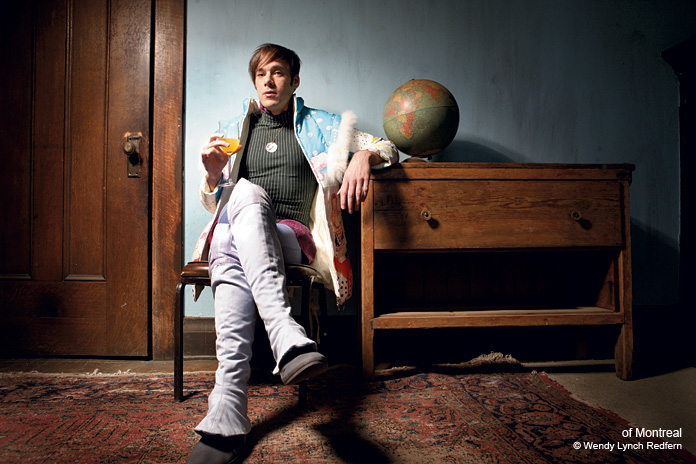
of Montreal
Disconnecting The Dots
Nov 30, 2010
Photography by Wendy Lynch Redfern
Issue #29 - Year End 2009 - Best of the Decade
![]()
As the 21st century dawned, of Montreal were ready for their breakthrough. Having already completed one indisputable (though overlooked) psychedelic pop classic in 1999’s The Gay Parade, they had staked out territory as the most whimsically kaleidoscopic, playfully childlike, and innocently asexual band in the then-fading Elephant 6 Recording Company. But just as E6 leading lights Neutral Milk Hotel and The Olivia Tremor Control were drifting into inactivity, in 2001 Kevin Barnes and his band of merry surrealists were readying what they believed would be their magnum opus, a sprawling 22-song concept album titled Coquelicot Asleep in the Poppies: A Variety of Whimsical Verse. It would tell the story of a fairy that becomes a human, befriends a mad scientist, and fights zombies. The silence was deafening.
“I was just so excited about psychedelic concept albums like The Beach Boys’ Smile and Pretty Things’ SF Sorrow and The Who Sell Out, and I wanted to make our version of that. I felt really proud of it,” Barnes says. “But then we took it out on tour, and it was the same thing. We’d get 30 people at our shows, and we’d be on tour for a month, and we were broke after doing it for five years. The stuff we did was so anachronistic that a lot of kids who were in their 20s, they didn’t really know Ray Davies or Os Mutantes—our influences at the time.”
Barnes shifted focus with 2002’s Aldhils Arboretum, a comparably condensed album that relied on no grand conceptual designs. But like its predecessor, Aldhils Arboretum failed to expand the band’s fanbase. And while the music was still unflinchingly melodic, a dark current began to churn beneath the surface.
“There are still some sweet songs on there, but it was becoming a bit more cynical and less whimsical,” he explains. “And I guess that evolved into [2004’s] Satanic Panic [in the Attic]. I would never have dreamed of using the imagery of Satanic Panic on previous records, and I guess I got into grotesque literature and grotesque imagery a bit more—Jean Genet and William Burroughs—and that started influencing me. It’s such a rich, strange world that they created, and I abandoned that sweet, whimsical world. It’s easier for me to write like that if it has those ideas and creates this imagery that no one is really messing with in the pop world. I love dance music, but I thought that dance music lyrics were so cloying and innocuous and meaningless, just about girls and boys and love and heartbreak. I wanted to make dance music with slightly less obvious lyrics.”
The appeal of the music was obvious, however, and Satanic Panic’s electronic makeover made of Montreal an international sensation, with increasingly complex live shows packing clubs around the world. A follow-up, 2005’s The Sunlandic Twins, continued their lucky streak, with songs turning up in TV commercials. Barnes got married, had a daughter, and shuttled back and forth between Norway and his Georgia home base, writing and recording at a feverish pace. But just as of Montreal’s commercial fortunes were turning, Barnes’ personal life was falling apart.
“I’ve only really been in one relationship my whole life,” he admits. “I kind of avoided love and it had to be this perfect thing, or I wouldn’t even try for it, and, of course, nothing is perfect, so I was basically celibate for all of those records. Then I met Nina and started evolving emotionally, and I was able to write from what you might call a more emotionally unique perspective, and Hissing Fauna [Are You the Destroyer?] is all about our falling out and breakup and how she moved away. That had a profound effect on me. At the time, I was really writing as a survival method, because I was in such a terrible state.”
In doing so, Barnes created an alter ego, a middle-aged African-American transsexual named Georgie Fruit who was as sexually confident as Barnes was inhibited. With a variety of hot pants, halter tops, and mesh shirts, sexuality moved into the forefront of of Montreal’s live shows, and those themes formed the backbone of 2008’s Skeletal Lamping.
“I got excited about exploring sexuality and gender roles and things that you don’t really see too much in pop music. Also, I was getting into Prince and had a love affair with listening to ‘70s soul music and R&B, and those are the sexiest forms of music in a lot of ways, so I utilized that spirit a bit on the record. Sly Stone, Stevie Wonder, Prince, and Isaac Hayes—those records had some amazing qualities to them, and I listen to them pretty much exclusively now,” he says, offering a possible preview of his next stylistic shift with 2010’s tentatively titled False Priest. “I almost never listen to The Beatles or The Kinks or anything like that.”
Current Issue

Issue #72
Apr 19, 2024 Issue #72 - The ‘90s Issue with The Cardigans and Thurston Moore
Most Recent
- Bat For Lashes Shares a Cover of Baauer’s “Home” From Her New Album (News) — Bat For Lashes, Baauer
- Premiere: Veronica Lewis Shares New Single “Disconnected” (News) — Veronica Lewis
- The Decemberists Share New Song “All I Want Is You” (News) — The Decemberists
- Ella McRobb Releases New Single “Slow Motion Heartbreak” (News) — Ella McRobb
- Light Verse (Review) — Iron & Wine

Comments
Submit your comment
There are no comments for this entry yet.